Top 10 hacking, coding and computing games
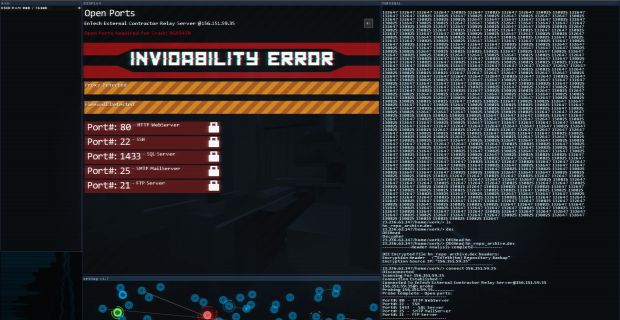
As everyone knows from the news feeds, we live in a constantly evolving cyberpunk dystopia . People connect toilets to the Internet ! If this Gibson world seems too REAL, then you can play the top ten video games about hacking, programming, and computing to escape to meta-anti-utopia. Which I am sure is a much better place.
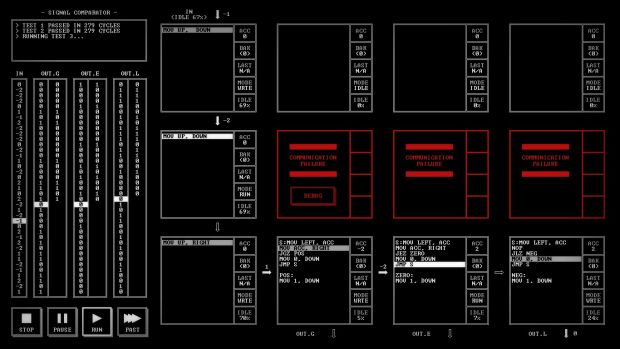
10. TIS-100
[ official website ]
Yeah, get ready for your brain to start hurting. TIS-100 is a game by Zachtronics Studios, a puzzle game developer who released Infinifactory and SpaceChem . In marketing, it is positioned as "a game about programming in assembly language, which you did not ask for," and although I usually ignore marketing slogans, I cannot but agree here.
')
The player has at his disposal a mysterious computer from the 70s, found in the things of the late uncle. Once he was playing with him, trying to figure it out. Now this is your task. In short, you need to get the numbers to drive the car from point A to point B by completing at each level “goals” (for example, first print a positive number and then a negative one). To do this, you have a list of commands set out in the vague user manual. The game advises you to print this manual in paper form. It has uncle made notes and notes with a marker, giving hints about the essence of this car.
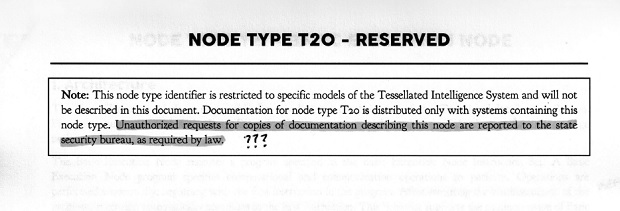
It is also a brain-exploding game about logic and mathematics. A math that should be obvious and simple, but it still somehow causes you trouble. But even if you suffer, you can still appreciate the reasonableness of the entire system - mechanical clicks and noises, flickering numbers running inside the car. Passing the first levels often makes the player filled with pride, gives him a sense of joy, as if he had just cracked the Enigma cd. Then he enters YouTube and sees the madness ahead .
Note: Zach from Zachtronics is a fan of hacking electronics and code. Here he makes a programmable typewriter , and here he plays with the undeciphered code of the awful old Star Wars game that he liked as a child.
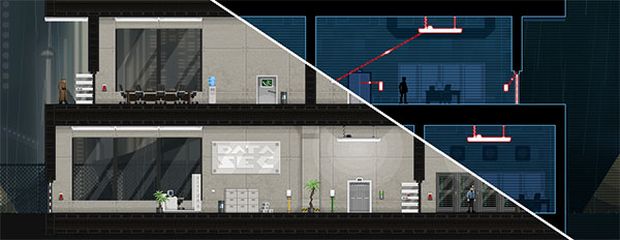
9. Gunpoint
[ official website ]
Spy cloak pants have never been so attractive. In Gunpoint, your mysterious spy character has to break into protected buildings and steal data for its customers. For this, he has a Crosslink - a device that allows you to control the wiring of each level. In essence, you play as a secret electrician with gadgets that allow him to manipulate buildings. You can change the wiring of the light switches to give the guards a shock, play around with the elevator, move it up and down, and (eventually) even reflash the weapon. Because it is a dystopia.
But everything is not limited to wires. Gunpoint has a love of eccentric violence. You can hit the guard in the face with the door that opened, jump off the ninja-style ceiling or hit him from afar and throw him off the roof so that he collapses when falling into a dozen pieces. I think that is called "social engineering".
Notes: developer Tom Francis was once a game journalist, which is objectively the most honorable occupation in the world, but then he started creating Gunpoint in GameMaker. Having a hard way of learning, Tom created a series of tutorials on YouTube to help people learn how to use this program.
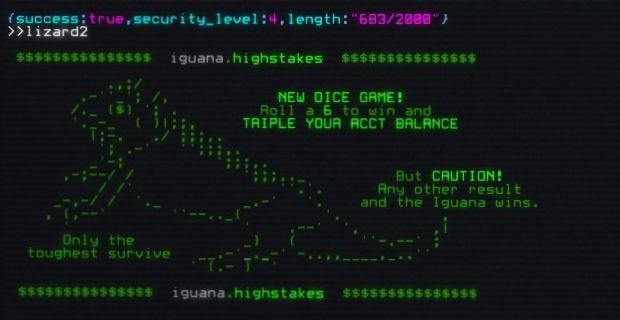
8. Hackmud
[ official website ]
Hackmud is a terrible and beautiful place. The player exists in the role of an AI-bot inside the network world of the future. People have long since died out (or disappeared in the depths of space, which is a bit more meaningful). You have to collect and earn virtual currency GC, because for this and such disgusting creatures live. Yes, unfortunately, there are others . This is an online hacking game in which another player can hack your account, steal all the hard-earned digital coins, drag off your tools (small code-decoders, etc.) and communicate your location to everyone. If this happens, you will turn into a pile of garbage, a small bot. Time to start all over again.
In this world it is difficult to understand and you will not be able to take advantage of all of its capabilities if you do not spend a little time studying basic Javascript (if you don’t know this programming language yet). In terms of MMO, the game is similar to EVE Online . The stakes are high, the complexity curve is insane, and the universe is overflowing with scam masters. I know for sure because I was one of them . Therefore, Hackmud is not a game for everyone. But for those who dare to get into the Petri dish with paranoid nullities, this will be a crazy adventure.
Notes: Hackmud became our favorite MMO 2016

7. Minecraft
[ official website ]
Sorry, I was trying to find a good reason for not needing to be included in the Minecraft list. This is a survival game. In it, you can beat trees with your fist. She infected millions of innocent children. But the more I tried, the more difficult it was to overlook the frivolity, experimentation and creativity of the masterpiece of the indie superstar Mojang. First, people started creating 16-bit computers inside the game, they made huge circuit boards with RAM capable of performing division operations, then they created landscapes-music boxes capable of playing entire songs , then they pretended the previous games of Notch inside the game , then They created ALL DESKTOP COMPUTERS with functional keyboards. Then they created the hard drives to save the results of their hard work, and then, since they needed to store all these machines, they recreated Denmark entirely . Even our site took part in it - one of the authors Rock, Paper, Shotgun and the living IQ standard Duncan Djir gave readers lessons on writing code , using this game as a learning tool.
I can understand if many people believe that Minecraft is no longer about hacking and programming, but for hackers and programmers. But from the examples given by me it is clear that this is enough to get on our list.
Notes: Of course, Minecraft is not a game for all hackers. In June 2011, the hacker group LulzSec disabled the game servers during a series of attacks on video game companies. Other victims include Eve Online, Bethesda, Sony, Nintendo and The Escapist.
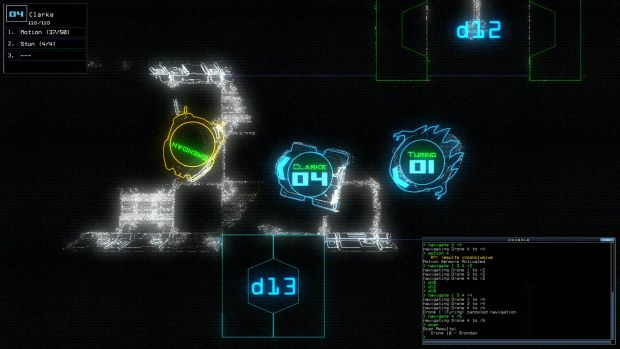
6. Duskers
[ official website ]
Remember the opening scene from Aliens when a small drone penetrated Ripley’s rescue capsule and scanned the room with a broken blue light? This is how the Duskers gameplay feels. The player controls a team of drones looking for debris among the stars. Your ship needs recyclable resources and fuel. To get them, you need to land on abandoned (for not very understandable reasons) ships, like garbage hanging around the galaxy. Any other designer who would have been given such a plot would have thought: “Aha, control point-and-click, plus maybe hotkeys.” But not Misfits Attic. To do this work, you basically have to use the terminal command line.
Such a move perfectly matches the atmosphere and graphic style of the game. The user interface is clumsy and resembles the future, as seen in the 1970s with the example of the Nostromo, right down to the pause menu. With the ship in front of you, you enter commands to move the drone to the power connector and generate electricity. Enter a few more commands and open the door. You are slowly traveling through the debris, hoping that beyond the next door you are not expecting an alien threat. That would be terrible news. Your helper robots are so fragile, as if made from the screens of modern mobile phones.
Many hacker games are associated with panic and quick command entry under the pressure of circumstances. However, in Duskers you need to be meticulous. Use scanners and motion sensors to recognize hostile life forms. Throw "alien" from the ship, remotely opening the air locks or luring them to the turret. The game becomes even more intense due to the roguelike structure and FTL-style fuel consumption.
Notes : in the game you can create your own teams using the "alias" command. For example, entering “alias getoutofthere navigate 1 2 3 4 r1” you will get an inconvenient “getoutofthere” command, with which you can force all drones to return to the air gateway.
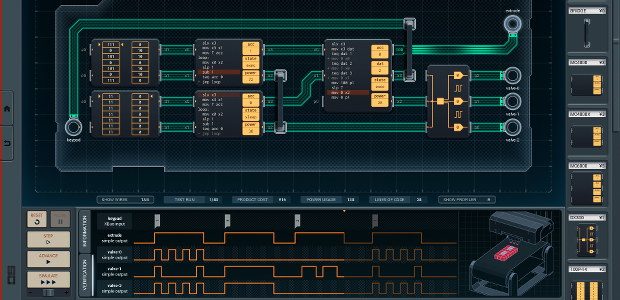
5. Shenzhen I / O
[ official website ]
Another Zachtronics game? Well, if you decide that your game will unfold inside the invented operating system, then why stop at only one? The user plays the role of an immigrant living in industrial China and working for Longteng, an electronics manufacturing company. The player receives an email notification and tasks. He will create devices for different clients. Sometimes it is something simple, like a flashing neon sign, and sometimes something more ... mysterious. In any case, the player will have to consult the manual that the game recommends printing and folding into a folder (and I agree with this advice).
In many ways, the game has become a spiritual follower of the aforementioned TIS-100 . You are still fiddling with numbers, moving them from one node to another using simple programming, and trying to optimize device circuits for the most efficient operation possible. But this time you need to take care of the components. You move the circuit board chips, switches and accessories. There may be several solutions, so try not to get confused.
Notes: if all of these puzzles have goosebumps, you can look at the latest Zachtronics Opus Magnum game, it is more accessible and simple. It is dedicated to engineering solutions to alchemical problems using balls of different elements.
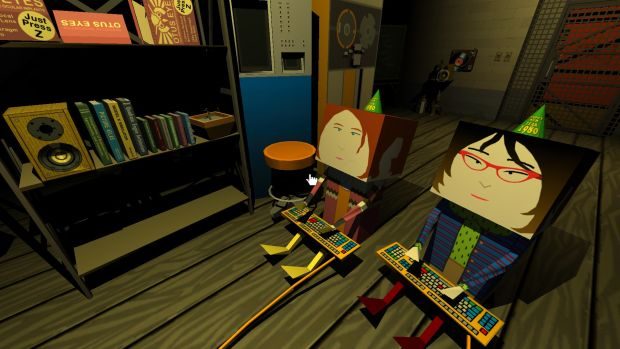
4. Quadrilateral Cowboy
[ official website ]
The creator of Thirty Flights of Loving and Gravity Bone is in love with robberies and robberies, and this becomes obvious when he decides to make a game lasting longer than a few minutes. In this game you control a team of thieves. Until you gain control of the whole trio of characters, you will mostly play for the Hacker. Each level is a small puzzle that can be solved by entering commands into “decks” - a laptop computer in a briefcase with a 56k modem that you bring to every residential house, bank vault or space station (yes, you will go into space). The commands are simple, for example, entering “door4.open (3)” will open the “door number 4” for three seconds. Using them, you need to penetrate into closed rooms, avoid cameras, lasers and alarms, pick up what you need and run off.
The game is not ideal - it dumps its best ideas to the player too quickly and ends earlier than the player hopes - but it has a list of leaders that encourages them to go over in their attempts to outperform the results of friends. More importantly, her vision of the retro-cyberpunk Nuevos Aires is detailed and stylish, and the story presented without words is strange and tender. Hacking games sometimes neglect the details of the real world and are limited exclusively to the screen. The Quadrilateral Cowboy reminds you that a computer is just a means to change reality.
And the game has a terrific cat .
Notes: almost immediately after the release, Blendo opened the source code of the game, and she won the main prize of 2017 at the IGF.
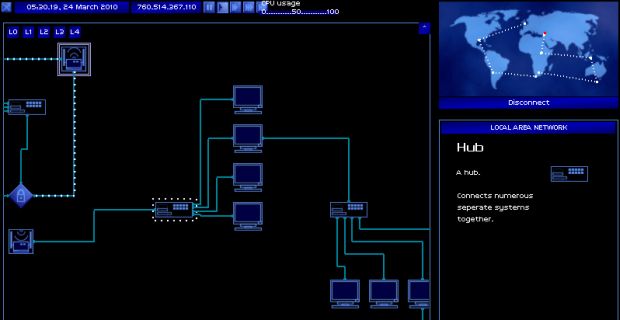
3. Uplink
[ official website ]
About this game is often remembered when it comes to "simulator hacking." When Introversion released Uplink, it rather changed the idea of how a good cyberpunk game for PC should look and feel. Playing on your own pseudonym on “computer in computer”, you take the position of a hacker for hire. Soon, you start hacking networks to change records, steal data and delete unwanted files. On your way, you discover new programs and upgrade the machine to crack more durable and frightening systems. You should also confuse your location with multiple IP addresses around the world. It fits well with the modern cinematic concept of hacking - a scene from the Golden Eye, in which Natalia traces Boris's traces or digital robbery in Password-Sword Fish.
But in Uplink is not so simple. The game does not forgive mistakes: your proxy machine and bank account will often be confiscated by the Law, after which you will have to start all over again. You can “save” progress by customizing the game files themselves, which can be interpreted as an excellent meta-puzzle.
However, with all this, Uplink easily became a cult classic and paved the way for all other games that followed in its footsteps. The next game in this list definitely did not appear without the influence of Uplink.
Notes : Uplink is the first Introversion game. In 2006, there was a legal dispute with a distributor in the US selling a version of the game called Uplink: Hacker Elite. After the distributor filed for bankruptcy, he stopped paying Introversion royalties, but continued selling the game. Conflict with time has been resolved.

2. Hacknet
[ official website ]
Hacknet passed by some critics. As in Uplink, the player assumes the role of a computer user, a sweeping IP address and communicating with the underground hacker communities. An unknown well-wisher named “Bit” sends you a strange new OS, which is essentially a set of hacking tools. But do not worry about him - he is already dead. The true pleasure of the game is not to find out the causes of his death or the origin of the OS (although this is an interesting start), but to use the command line to launch programs, examine the folders of hacked machines and arrange a big commotion. Bonus: WipeOut soundtrack will help you to get deeper into the game.
The game has mouse controls (for example, you can select files by clicking, rather than typing their names entirely), but the deeper you dive into the new sphere, the more speed you need to remain in order to remain elusive. Using serious terminal commands in the style of Linux becomes your second nature. In the early stages of the game there is a great moment with a rival blackhat hacker and an interesting moral choice. Not to mention a completely separate plot line for players with more criminal inclinations. As I said, the idea of the project owes much to Uplink. But the implementation of Hacknet is an excellent game. A few words written with mistakes and one or two bugs do not prevent her from being stylish, interesting and pleasantly short.
Notes: if your computer has a CD drive, then when you type “openCDTray” in the Hacknet terminal, the CD tray will actually open. This team was supposed to be used in a multiplayer version of the game, but, alas, this mode never appeared.

1. else Heart.Break ()
[ official website ]
When you start playing this vibrant Scandinavian adventure game, you might think that this is a slow and sluggish point-n-click with absolutely no purpose. But be patient a little and you will find that this is one of the smartest games you can play. In Heart.Break () you get accustomed to the role of Sebastian (or Seb, if you like), who moved to the big city of Dorisburg after receiving the position of a seller of soda. You walk through this strange city, selling jar after jar to capricious residents, most of whom don’t even need them.
How does all this relate to hacking? When you start your career in the brave new world of soft drinks, you start to make friends (and a girl, of course). It becomes obvious that in fact they are a group of hacktivists fighting against the monstrous Ministry of Computing. Soon you get your own "modifier" - a device that allows you to hack any object in the game.
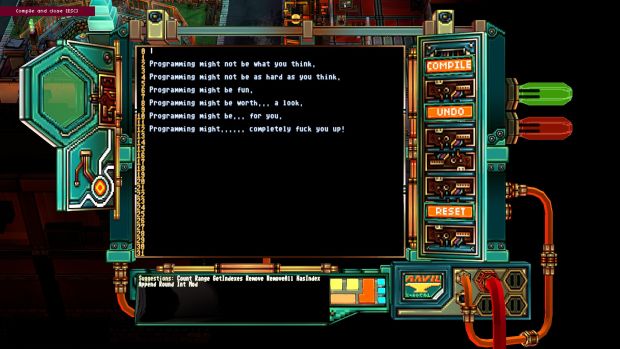
At this point, Heart.Break () is transformed. You begin to wander around the city, studying the code of everything your hands reach. You find people who teach you to read and write this code in the full-featured SPRAK programming language (“language” in Swedish). You start experimenting with everyday objects in ways that allow you to cheat in the game. For example, Sebastian usually gets tired every day, and you have to go to bed to restore energy, otherwise you will not stand it. But what if you manage to break a glass of water in order to reduce your “sleepiness” rate by a factor of a hundred? Such small touches are just the beginning. Do you want to break the door so that with the help of it you can jump half the city? Try it. Do you want to transfer your body over the Internet to the city’s central financial computer? This is possible. Would you like a la Tyler Durden to rewrite the software of this financial computer so that all bank accounts would drop to $ 0 and the money itself be canceled? Do it. I managed. And I did not regret a single line of code.
But the most surprising thing about Heart.Break () is her admiration for humanity and youth. The gameplay is not just a gloomy green glow of the screen, it is a functioning city with drunks, smokers, working factories, corridor hotels, homeless people, activists and bureaucrats. You see how all the changes you make affect the world around us, living regardless of your actions. And this world itself is a bright, amazing place: the artistic taste of Nicklas Okeblad and other members of the team gave him energy that is not usually associated with computer programming. Mental, lively and smart else Heart.Break () does not stop at creating a sense of control by a hacker. Here you are more like a wizard.
Notes: In March 2015, the colorful team of Swedish programmers and artists who created the game conducted a secret game game in Gothenburg (which was by coincidence a source of inspiration for creating Dorisburg). The goal of the jam was to create simple little games at SPRAK itself. The resulting mini-games can be found in the arcade machines of Dorisburg.
Source: https://habr.com/ru/post/374051/
All Articles